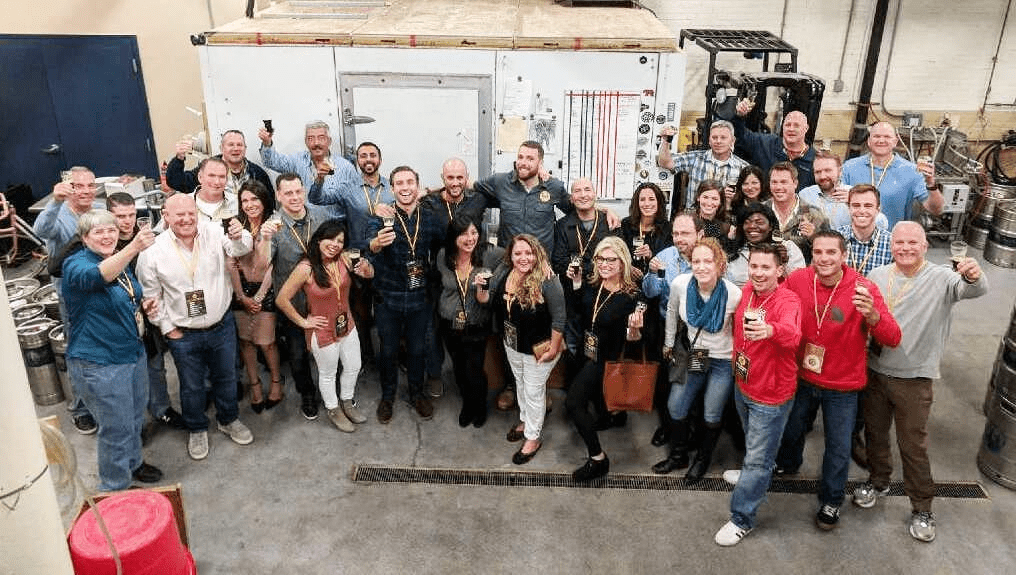What is Team Building?
Team building is the process of improving group dynamics in the workplace. Usually, it takes the form of game-like activities that form social bonds. Team bonding increases creativity, improves speaking and listening, increases problem-solving, decreases sick leave, improves employee retention, and drives sales.
When you invest in team building, employees start thinking as a group. They become more emotionally invested in one another. Even if team building doesn’t turn employees into best friends, it still creates bonds of trust that improve specific, measurable business outcomes.
How Do We Measure Team Building?
Imagine a race with no finish line. That’s what it’s like to do anything without a reference point. To understand how you are improving, you need a frame of reference. If you don’t have one, you won’t know how much you’re moving forward.
Fortunately, psychologists who study peak performance, known as “flow,” claim that having a frame of reference helps athletes and other top achievers do their best work. The feedback helps them course-correct and win. They enter the zone.
Excellent team building metrics will do the same thing for you as a manager or team leader. It comes down to getting the right measurements, the right metrics.
You are probably starting to ask: “What metrics do you use to measure team performance?” To answer, we’ve listed some reliable formulas, indicators, and metrics below.
Employee Attendance
If employees stop showing up to work, there might be an emotional and organizational cause. Employees who feel upset with their workplace can decide to spend their time elsewhere. These absences costs you money and shoulder you with a lot of extra work.
Employee absences are also a sign of lousy team dynamics. If employees don’t feel supported by their team, they stop enjoying work.
Pro tip: measure absenteeism with the following formula. Divide the total number of days absent by the total of days attended. This gives you the absenteeism rate.
Client Satisfaction
The Buddha says, “The clear mind produces clear results.” The same applies to team building. If your team dynamics are rotten, your customers will feel it.
Your clients are a reliable indicator of team success. That’s why we suggest using customer surveys to measure the potency of your teams. Also, consider customer loyalty and the Customer Effort Score (CES), the ease with which a customer interacts with your team.
Employee Turnover
If your employees are regularly quitting, you might have a team building problem. We suggest measuring the following retention factors. First, look at your overall retention and new hire rates. Then look at the average length of employment and compare the amount of new vs. existing employees. Finally, look at how long your star employees stick around and then consider how much employee turnover costs you.
Employee Satisfaction
If employees like their job, then you probably have quality team dynamics. But how do you measure employee satisfaction? Try using a survey to gauge satisfaction and engagement. In the questionnaire, also measure Net Promoter Score. Ask employees how likely they are to suggest that someone apply to your company.
Surveys are not the only way to measure team success. Try checking in with your employees. A casual conversation could tell you tons about how employees feel at their job. Plus: if your employees feel comfortable telling you about their feelings at work, it’s an excellent sign of good team building!
Productivity
Productive teams are effective teams. But how do you measure team productivity? With two metrics. First, look at your revenue per employee. Second, look at the total cost of your workforce. These will tell you a lot about how much employee productivity costs you.
How Do You Measure Team Building Success?
- Check Your Metrics First
- Enjoy the Initial Push
- Settle into a Groove
- Sustain Your Momentum
- Ask for Feedback
- Look at the Long Term
- Get Feedback
1) Before You Begin Any Team Bonding Activity, Check Out Your Baseline Metrics
Your metrics are your guide and will tell you how to measure team effectiveness. Employ the measures we provided above. Once you get a firm hold on the numbers, you will be in an excellent place to begin team building.
Then try doing a team building activity. It can be simple. If you want suggestions, check out our top team building games!
2) Enjoy the Initial Push
After a vigorous team building activity, you will probably notice a marked increase in productivity. This is normal. But, this initial push won’t last. Your results will begin tapering off. What does this mean? Enjoy the increased productivity, but you’ll have to wait before you can get a reliable measurement of your team building success.
3) Settle into a Groove
By the second week, employees will settle into a groove. Once they do, you will be in a stable place to forecast the longer-term benefits of your team building efforts. Though this still isn’t the perfect time to assess your progress, you will start getting a feel for how well things went. And you can implement small course adjustments if you need them.
4) Sustain Your Momentum
One month after your team building exercise, take some final measurements of how much your productivity increased. These are the most reliable numbers for your analysis, and they will stay more constant over time. From here, you can appraise how much more team building your company requires.
5) Ask for Feedback
Two heads are better than one, but your team knows best. Your staff has a wealth of knowledge. Ask your employees what they think about your team building efforts. How do they feel about communication in the workplace and group dynamics? How about creativity and job satisfaction?
You can also get your employees talking about your team building event itself. Have your staff identify what they learned at the event. Then, have them forecast how they might apply what they learned to real work problems.
You can also use the Team Development Measure (TDM), a popular survey for gauging how employees feel about their teams. It gives a robust overview of team dynamics. It asks employees how much they agree with 31 different statements on the quality of their team. The TDM is a great way to get the conversation started.
Remember, your staff feedback is some of the most robust data you can gather. Plus, when you seek honest answers from your staff, you are putting the values of healthy team dynamics into practice.
6) Long Term
As time moves on, keep tabs on your outcomes. Tracking will help you get the most from your team building investment. Measure your financial returns. Return to your team building metrics. And use them to forecast future team bonding needs.
Also, spread your positive growth to other departments in your company. If team building helped IT, schedule an activity for the finance department. Every part of your company will benefit from quality team dynamics. And, when multiple departments master their teamwork skills, your entire company will become a more synchronous and connected community.
7) Get Feedback
The most well adjusted teams stay in constant communication. Be sure to provide plenty of opportunities to hear your employees both anonymously and in person. This can be accomplished by providing an anonymous survey, feedback forms, and through personal one-on-ones.
Start Today
Successful businesses budget for team building because they see it as an investment. Team building, for them, is not a short-term cost, but an excellent investment, like upgrading equipment or pursuing some specialized training. They see it this way because team building improves the most important part of their company: their employees. A place is its people, and successful businesses know this.
Like all fruitful investments, a team building investment will grow over time. If you use the right metrics, you will have the ability to see exactly how much this vital investment has improved your company. We invite you to employ the metrics from this post to use as a guideline to manage the investments you make in your team.
If you are still reading this, it may be because you are already shopping for excellent team building activities for your staff. If that’s the case, we invite you to check out our customized CityHunt scavenger hunts. They are unique quests that send your employees through an epic of city exploration and team building fun. We have options in dozens of U.S. cities. In addition to being fun, our scavenger hunts are built on research from the University of Pennsylvania and Stanford. We designed them specifically for fun and reliable team building results.
If that excites you, we invite you to complete our contact form right now and start the conversation. Once you fill out the form, we’ll give you a phone call and discuss the best scavenger hunts for your company or organization. Or, if you would like, give us a call at (1-877)-HUNT-FUN. Either way, we will provide you with a free quote and talk shop with you about team building, giving you access to our research and experience.




